Published in British Academy Review, Issue 21 (January 2013).
The print version of this article can be downloaded as a PDF file.
For the first 25 years of its life the British Academy had to make do without a permanent home. Instead, it lived a hand-to-mouth existence totally dependent on other organisations for rooms in which to hold its meetings and lectures. However, in 1927, the Academy finally received the news it had been awaiting from government; responding to the latest petition from the Academy’s President, the Chancellor of the Exchequer, Winston Churchill, wrote: ‘I am so glad to tell you that what you wish has been arranged, and … in recognition of the position of the British Academy and its services to the nation, the Government has decided to assign it free quarters in Burlington House.’ The President was able to announce the good news to the Fellowship at the British Academy’s Twenty-fifth Anniversary Dinner, held on 14 July 1927 [note 1].
The Academy was allocated space in the east wing of Burlington Gardens where the University of London’s lecture theatre had originally been situated [note 2]. This area required considerable adaptation which the Academy could not afford. Fortunately, ‘a friend of Sir Israel Gollancz’, Secretary of the Academy, came to the rescue as an anonymous benefactor and building work was able to proceed. The architect, Arnold Mitchell, redesigned the space so that the Academy could have ‘a large and a small Lecture Room (capable of being thrown into one), a Council Chamber, two rooms for secretarial purposes, and (on an upper floor) accommodation for a library’ [note 3].
The formal opening of the Academy’s rooms on 24 July 1928 was to be an occasion of some significance, and had attracted some advance press attention. On 22 July the Observer offered its readers the following description: ‘The Council Room is a particularly handsome apartment, panelled to the ceiling with walnut. The centre of the ceiling is domed and elaborately ornamented, and has screened lighting and ventilation. The Chamber opens into a large lecture and conference room, which can be used either as one or two rooms, with galleries occupying one side.’
But the name of the benefactor was still not public knowledge. The day before the opening, Gollancz received a letter from Sir Charles C. Wakefield, Bart., formally consenting to be identified as the donor (Figure 1). Charles Cheers Wakefield (1859-1941) was a Liverpool-born entrepreneur, and was the man behind Castrol lubricating oil. The Academy had already benefited from his largesse. At an event to mark the tercentenary of the death of Sir Walter Raleigh in October 1918, Wakefield had offered the Academy ‘the sum of £500 per annum for at least five years as the nucleus of a Raleigh Fund for History’ [note 4]: the Academy’s annual Raleigh Lecture on History is an enduring reminder of this generosity. And as a guest at the Academy’s Twenty-fifth Anniversary Dinner, Wakefield had announced that he was presenting the Academy with a portrait of its President, Lord Balfour, by Sir William Orpen, RA [note 5].
Letter from Sir Charles Wakefield, Bart., to Sir Israel Gollancz FBA, Secretary of the British Academy, 23 July 1928 (BA359).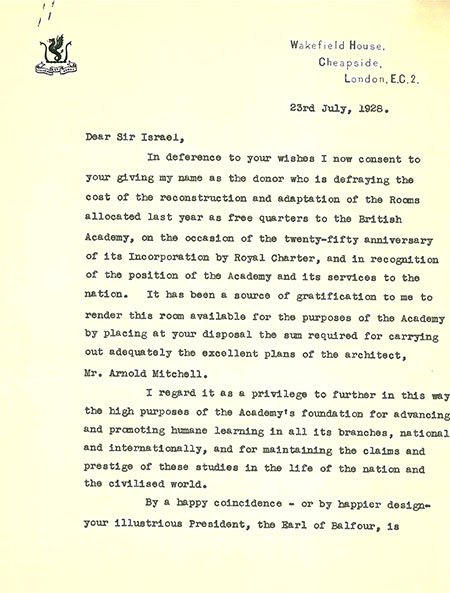
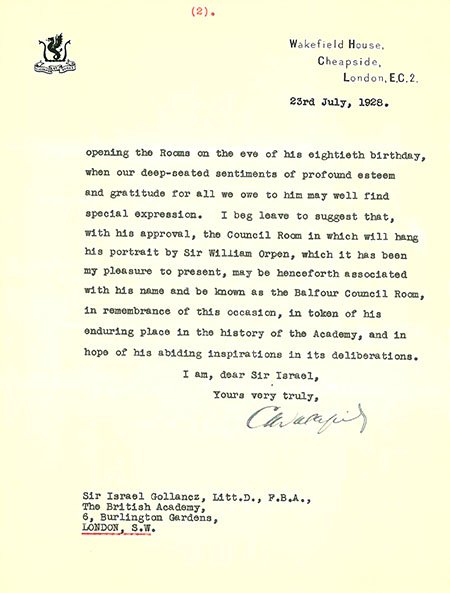
The Academy’s new rooms were formally declared open at noon on 24 July 1928 (Figure 2). The ceremony was followed by a lunch at the Prince’s Hotel. The lunch, attended by HRH the Prince of Wales, also celebrated Lord Balfour’s 80th birthday.
Figure 2. The opening of the Academy’s new rooms on 24 July 1928. Standing from left to right in the Council Room: Dr J.W. Mackail (future President 1932-36); Sir Frederic Kenyon (past President 1917-21, and future Secretary 1930-49); Sir Charles Wakefield (benefactor); Arnold Mitchell (architect); the Archbishop of Canterbury; the Lord Mayor London; Lord Balfour (President 1921-28); H.A.L. Fisher (future President 1928-32); Sir Israel Gollancz (Secretary 1902-30). Photograph from ‘The Times’, reproduced in Mortimer Wheeler, ‘The British Academy 1949-1968’. Above the fireplace is the portrait of Balfour, by Sir William Orpen, donated by Wakefield – shown in the lower image.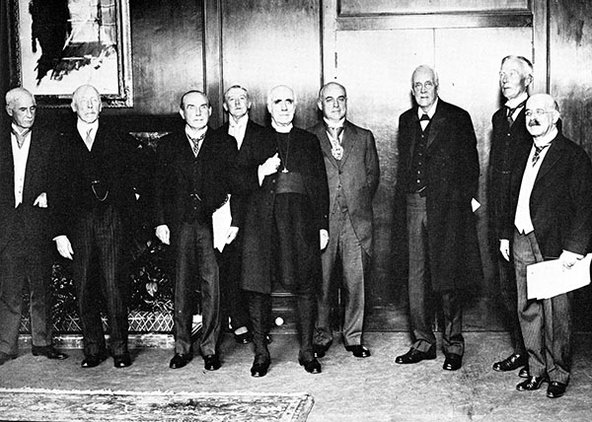
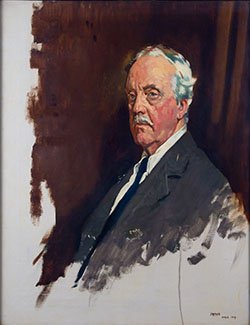
On 1 May 1929, a tablet to record Wakefield’s generosity was unveiled in what was the Academy’s large Lecture Room, where it can still be seen (Figure 3) [note 6]. This room at 6 Burlington Gardens is shortly to be demolished to make way for new refurbishments by the Royal Academy, but it is hoped that the tablet can be moved to the British Academy’s present home in 10-11 Carlton House Terrace.
Figure 3. Tablet in 6 Burlington Gardens commemorating Sir Charles Wakefield’s generous donation.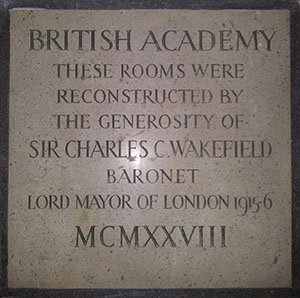
In 1938, Wakefield (now Viscount Wakefield) was elected to be an Honorary Fellow of the British Academy.
Notes
1. ‘Annual Report, Session 1927-8’, Proceedings of the British Academy, 14, p. 19. See also ‘Winston Churchill and the British Academy’, British Academy Review, 20 (Summer 2012), pp. 45-7.
2. A picture of what this lecture theatre looked like in the late 19th century can be found in British Academy Review, 12 (January 2009). The British Academy had hired this venue for its own public lectures.
3. Frederic G. Kenyon, The British Academy: The First Fifty Years (1952), p. 32.
4. ‘Annual Report, Session 1918-19’, Proceedings of the British Academy, [9], pp. 15-16.
5. ‘Annual Report, Session 1927-8’, p. 19.
6. The tablet was designed by Macdonald Gill. ‘Annual Report, Session 1928-9’, Proceedings of the British Academy, 15, pp. 15-16.